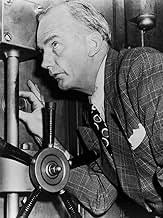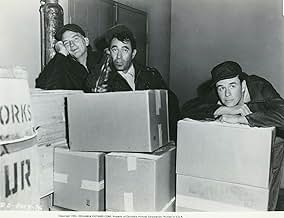Une réforme du régime pénitentiaire ayant été décidée aux Etats-Unis, un jeune psychiatre, le docteur Wilson, est chargé de mission au grand pénitentier de Harbor State pour étudier les moye... Tout lireUne réforme du régime pénitentiaire ayant été décidée aux Etats-Unis, un jeune psychiatre, le docteur Wilson, est chargé de mission au grand pénitentier de Harbor State pour étudier les moyens de réformer le système pénitentiaire. Le film décrit ses rapports avec six détenus.Une réforme du régime pénitentiaire ayant été décidée aux Etats-Unis, un jeune psychiatre, le docteur Wilson, est chargé de mission au grand pénitentier de Harbor State pour étudier les moyens de réformer le système pénitentiaire. Le film décrit ses rapports avec six détenus.
- Réalisation
- Scénario
- Casting principal
- Récompenses
- 5 victoires et 1 nomination au total
- Dawson
- (as Henry Morgan)
- Jocko
- (as Charles Buchinsky)
- Bit Role
- (non crédité)
- Harry Higgins
- (non crédité)
- Convict #2
- (non crédité)
- Guard
- (non crédité)
Avis à la une
After some chicanery by a couple of inmates, and Doc's pointing out the advantages of lighter duty in working with him, half a dozen men come around. They agree to work on his staff, and they become the first to take his tests. Millard Mitchell plays James Connie who surreptitiously steers the Doc and the inmates through a successful effort. Mitchell gives a great performance and received a Golden Globe award as best supporting actor in 1952. Other prominent actors among the inmates are Gilbert Roland as Punch Pinero, Harry Morgan as Dawson, Marshall Thompson as Blivens Scott and Jay Adler as Steve Kopac.
The film is a fictional adaptation of a real story. An attempted prison break, killing and suicide aren't in the book. The source is a 1951 autobiographic book by Donald Powell Wilson, "My Six Convicts: A Psychologist's Three Years in Fort Leavenworth." While Fort Leavenworth is a federal penitentiary in Kansas, the setting and story for this film was at San Quentin, a northern California state prison.
The comedic light touch lifts this film and helps in the individual portrayals of the six convicts' lives in more depth. It's a film worth seeing if one can find it on DVD.
Cameraman Guy Roe, who started out with well-regarded B noirs like ARMORED CAR ROBBERY and later went into TV work, does some handsome work with good choices of angles. Look for the sequence in which the convicts get upset about the pitcher being withheld from the game.
Don't be put off by the overly earnest opening, as the new, wet-behind-the-ears psychiatrist arrives at the prison hoping to reform the penitentiary system single-handed. Although Kramer reportedly had prison reform in mind in making the film, this movie is not about psychological theories, which are lightly passed over with buzz-word gobbledygook. It's not even about the good doctor himself or his research so much as it's about the six cons of the title, as they become human beings to us.
Speaking of buzz-words, the genial Connie's psycho-babble malapropisms are among the best of the running gags. The many funny scenes stand out against the grim realism of the penitentiary, shot on location at San Quentin. The comedy also contrasts sharply with the dramatic dilemma the "doc" must face between gaining (and keeping) the confidence of his six cons and learning too much to be healthy in the deadly reality of prison life. But overall this is a human comedy more than an edge-of-your seat drama.
There are excellent photographic moments using long wide-angle shots to dramatize the starkness of the prison environment, which contrast well with the friendly intimacy gradually established in the psychiatrist's office. And the movie gets an extra star for the fine score by Dimitri Tiomkin, famous for many much better-known movies from "It's a Wonderful Life" to "The Guns of Navarone".
It's well worth watching for this to come around on television, as you are unlikely to find it at your corner video store -- not available on DVD or VHS at the time of writing.
Beal is sent to San Quentin and since that's where this film was shot, I'll use that as the prison name to find out to see if we can better rehabilitate convicts. Actually part of the answer is supplied in Goodfellas where Henry Hill says that people who work are stupid. Just take what you want at least until you get caught.
This film is about the thousands of guys who aren't connected who do wind up in the joint for one reason or another, that group you saw demanding their meals while the wiseguys were dining elegantly. As in every prison picture any place of incarceration has its own set of rules and code which one had better learn quickly.
Beal needs a staff and he comes up with six of them, Gilbert Roland, Millard Mitchell, Alf Kjellin, Marshall Thompson, Jay Adler, and Harry Morgan. All join up with Beal for their own reasons, but all of them worry about confidentiality, a real important thing in Beal's research. But it's also something that the cons worry about when it comes to being a stool pigeon. And that's a guy with no popularity and limited life expectancy.
The six convicts are quite a study in convict Americana. Although all of these guys are near and dear as great character players my favorites would have to be Millard Mitchell, Gilbert Roland, and Jay Adler. Mitchell is your old convict who knows the system inside out and how and when to play people to get what he wants, he was an ace safecracker by trade before going in. Roland is a gangster who is doing his time and waiting to be deported where on his stashed loot he's going to live the good life.
Adler was a truly sad case, a guy who got greedy and caught and who is a great example of recidivism. After he gets his parole he doesn't know what to do on the outside so he deliberately violates parole to get back. A truly institutionalized human being and between the time of the making of this film and now, no one has found a way to deal with that.
My Six Convicts from Columbia's B picture unit is a great film of some wonderful case studies of the criminal mind.
s
It did remind me of the later 1963 Oscar nominated prison film The Great Escape starring Steve McQueen, Charles Bronson and James Garner. Although the actors who starred in this lesser known film such as Millard Mitchell and Gilbert Roland never attained the star status of McQueen, Bronson and/or Garner their acting was top notch and most enjoyable.
This is a most under rated film and more than deserving of my 8 out of 10 IMDB rating.
Le saviez-vous
- AnecdotesMillard Mitchell was the first actor to win a Golden Globe Best Supporting Actor award without receiving a corresponding Academy Award nomination. The other 6 in chronological order are: Earl Holliman in Le Faiseur de pluie (1956), Stephen Boyd in Ben-Hur (1959), Oskar Werner in L'espion qui venait du froid (1965), Richard Attenborough in La canonnière du Yang-Tsé (1966) then L'Extravagant docteur Dolittle (1967) (these two wins in successive years), Richard Benjamin in Ennemis comme avant (1975) and Aaron Taylor-Johnson in Nocturnal Animals (2016).
- GaffesThe convicts manage to carry off an elaborate scheme to bring Randall's wife from Canada and smuggle her into the prison simply so Randall can enjoy ten minutes of marital bliss. But there is no explanation offered as to just exactly how they got her out again, nor why Randall didn't go with her, if they did, after it's all over.
- ConnexionsReferenced in Les frontières de la vie (1953)
Meilleurs choix
Détails
- Durée1 heure 44 minutes
- Couleur
- Rapport de forme
- 1.37 : 1





































